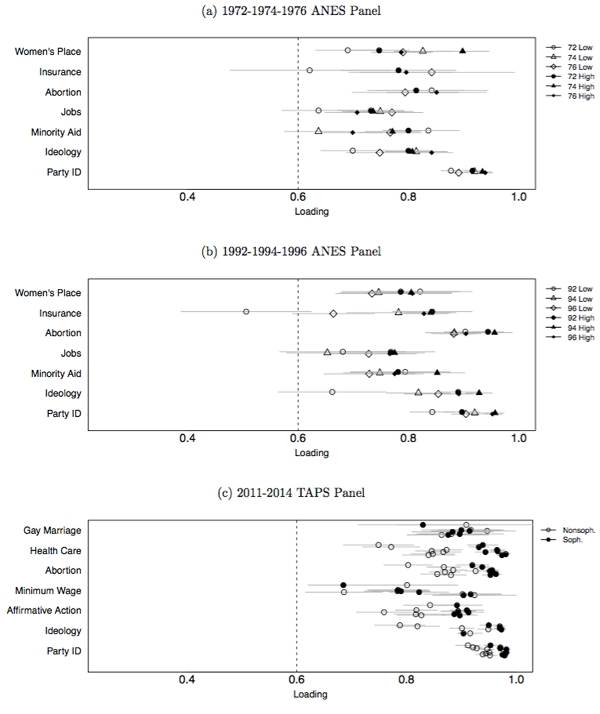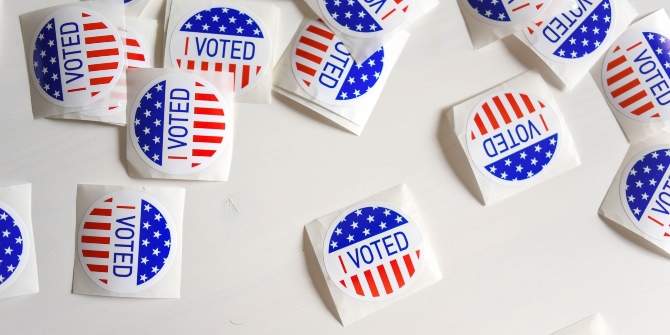
 The traditional view that voters have stable beliefs about what government should do and what policies they prefer has become unstuck, with many commentators and academics now doubting that voters approach politics with any consistent preferences. In new research, Melanie Freeze and Jacob M. Montgomery reject this view, arguing that public opinion is generally stable across many issues, and that the public is getting better at connecting their preferences to their ideology. By removing random and time-dependent errors from election and survey data, they find that preferences on a range of issues such as abortion policy and gay marriage have been relatively stable and have also become more closely correlated with party identification over the past two decades.
The traditional view that voters have stable beliefs about what government should do and what policies they prefer has become unstuck, with many commentators and academics now doubting that voters approach politics with any consistent preferences. In new research, Melanie Freeze and Jacob M. Montgomery reject this view, arguing that public opinion is generally stable across many issues, and that the public is getting better at connecting their preferences to their ideology. By removing random and time-dependent errors from election and survey data, they find that preferences on a range of issues such as abortion policy and gay marriage have been relatively stable and have also become more closely correlated with party identification over the past two decades.
At the heart of democracy lies an assumption that voters have meaningful beliefs about what the government should do and what policies are best. These preferences serve as a basis for the public’s evaluations of candidates and elected officials. If voters don’t have stable and structured preferences, how can they hold elected officials accountable or choose between candidates?
Nonetheless, distrust of the public’s ability to meet these requirements is all too common and the competence of the average US voter is often depicted in dismal terms. Founding father Alexander Hamilton worried that, “The voice of the people has been said to be the voice of God: and however generally this maxim has been quoted and believed, it is not true in fact. The people are turbulent and changing; they seldom judge or determine right.” More recently, Republican presidential hopeful Donald Trump asked “How stupid are the people of Iowa? How stupid are the people of the country to believe this crap?”
Skepticism about the abilities of voters – and even the existence of meaningful, stable preferences – is surprisingly common, even among academics. A large body of research suggests ordinary voters struggle to apply any abstract or ideological structure to politics and have very little consistency in expressed opinions from one point in time to another. Yet, if citizens’ basic issue preferences lack stability and coherence, democracy is in big trouble.
Along with some other scholars, we reject this pessimistic view. The American public’s preferences are not all that we could sometimes wish, but neither are they as flimsy a foundation for democratic politics as we sometimes fear. We find a widespread stability in public opinions on a variety of political issues and, surprisingly, that the public’s ability to coherently connect preferences in an abstract ideological structure has increased with time.
The key to unlocking this more optimistic picture of public opinion lies in our ability to clear away the cobwebs of error that obscure public opinion data as a result of the imperfections of the survey process. The average citizen, after all, does not often find herself offering opinions on dozens of political topics. Some level of error or randomness in how they answer pollsters’ questions is inevitable. Vague question wording, the survey setting itself, interviewer bias, the news of the day, and a myriad of other factors can affect how people answer survey questions. So when pollsters and academics interview the same respondent multiple times, is it surprising that their answers often change? And when we look to see if people’s answers across topics (e.g., preferences on abortion policy and tax policy) are coherently organized, is it really shocking to discover that their answers to one question are not always related to their answers to others? More critically, does the fact that citizens’ answers to survey questions are unstable and unorganized mean that their actual underlying preferences are as well?
To provide a clearer and more accurate understanding of the structure and stability of issue preferences in the public, we analyzed data from three separate panel surveys: the 1972-1974-1976 and the 1992-1994-1996 panels of the American National Election Studies (ANES) and The American Panel Survey (TAPS) panels waves that were collected between 2011 and 2014. The most important feature of these datasets is that the same individuals were interviewed multiple times across several years. Moreover, respondents were asked the exact same questions about their preferences in multiple policy areas. In all, six identically worded policy questions were asked on both of the ANES surveys and five similar questions were asked repeatedly on the TAPS survey (ANES: ideology, health care, minority aid, abortion, jobs, and women’s place; TAPS: ideology, health care, minority aid, abortion, minimum wage, and gay marriage).
With this data, we conduct a statistical analysis to explore the stability and coherence of public attitudes across three decades. Our model allows us to (in part) remove random error and correlated time-dependent errors in survey responses. That is, they give us better estimates of citizens’ underling preferences after stripping away some of the instability in response that is inherent in the survey process. The results allow us to see, first, how the underlying preferences of respondents correlate over time and, second, to what degree preferences are structured in a coherent and ideological manner.
As shown by the factor loadings displayed in Figure 1, individual issue preferences do appear to be stable across time when systematic and random measurement errors are removed. Party identification, as one of the most stable attitudes, provides a baseline for comparison. Even though years separate panel waves, people tend have relatively stable preferences. Standardized factor loadings, our measure of stability, can range from zero to one, but generally scores above 0.6 indicate stability as they show the existence of a strong relationship between the underlying trait (e.g., true preferences regarding abortion policy) and the individual item (e.g., response to an abortion policy question in a specific panel wave). For the issues examined (other than party identification), the average factor loading point estimate is 0.772 for the 1970s panel, 0.802 for the 1990s panel, and 0.897 for the 2010s panel. In comparison, party identification’s loadings for the respective panel years are 0.910, 0.915, and 0.958. While overall issue preferences’ high loadings show stability, preferences on abortion in the 1990s (factor loadings range from 0.896 to 0.919) and gay marriage in the 2010s (factor loadings range from 0.894 to 0.967) are nearly as stable as party identification.
Figure 1 – Preference stability: Factor loading by Wave

We also examine public preference structure in light of the increasing and ideologically coherent messaging at the elite level since the 1970s. Specifically, we argue that increased elite polarization, that is political parties’ ideological distinctiveness and internal homogeneity, should enable citizens to more easily structure their own issue preferences and partisan identities along ideological lines. Has ideological coherence increased from the 1970s to today?
One way to examine this is to look at the correlation between preferences on specific issues with the more abstract organizing attitudes of party identification and ideology. And indeed, there has been a marked increase in these correlations over time. For example, in the 1970s, preferences on abortion policy were only weakly related to ideology (0.207) and incorrectly related with partisanship (-0.120). When we examine these correlations in later decades, we find much more structure. In the 1992-1994-1996 panel, correlations between abortion policy preferences and ideology are greater. And while question wording is not as comparable, abortion preferences and ideology are more correlated for the 2011-2014 period. This pattern is repeated in nearly every issue domain.
Moreover, we find that this stability and increasing coherence is not restricted to some small elite group of politically sophisticated citizens who are highly interested in or knowledgeable about politics. Preference stability and structure appear to be widespread. Through a series of nested models similar to those discussed above, we find respondents who are politically unsophisticated have only marginally less stable preferences than politically sophisticated respondents, and the difference is neither dramatic nor uniform (non-sophisticate groups factor loadings for the most part are in the 0.70 to 0.90 range of stability). The difference in stability actually lies more with the abstract preferences of partisanship and ideology and does not hold for the responses to specific policy questions.
Further, when we examine preference correlations across issues at a different level, we find that respondents who may not know much about the details of politics still have ideologically structured attitudes. High sophisticates’ preferences are more ideologically structured than the preferences of low sophisticates, but structure can still be found among citizens many observers deem politically incompetent. Furthermore, our analyses show that the rise in preference coherence is actually concentrated among these low sophisticates.
In all, our analysis provides a rich and comprehensive argument that the general public has preferences that are more ideologically organized and stable than is often supposed. Is it enough to support and enable an accountable democracy? That is a difficult question to answer. But we believe that these results indicate that the answer is a more nuanced, “Perhaps,” rather than a simple, “No.”
This article is based on the paper, “Static Stability and Evolving Constraint: Preference Stability and Ideological Structure in the Mass Public” in American Politics Research.
Featured image credit: Joe Shlabotnik (Flickr, CC-BY-SA-2.0)
Please read our comments policy before commenting.
Note: This article gives the views of the author, and not the position of USAPP – American Politics and Policy, nor the London School of Economics.
Shortened URL for this post: http://bit.ly/23eG9xN
_________________________________
 Melanie Freeze – Carleton College
Melanie Freeze – Carleton College
Melanie Freeze is a Research Associate in the Department of Political Science at Carleton College. Her research focuses on party identity and political behavior.
 Jacob M. Montgomery – Washington University in St. Louis
Jacob M. Montgomery – Washington University in St. Louis
Jacob M. Montgomery is an assistant professor of political science at Washington University in St. Louis. His research in political methodology and American politics has been published in journals including the American Journal of Political Science, Political Analysis, and Political Behavior.





